When we select files and folders in File Explorer, Windows highlights them. This lets us know which files and folders are selected. What if File Explorer does not highlight the selected files and folders? Some users have experienced this issue on their systems. In this article, we will see what you can do if File Explorer does not highlight selected files and folders to fix the problem.
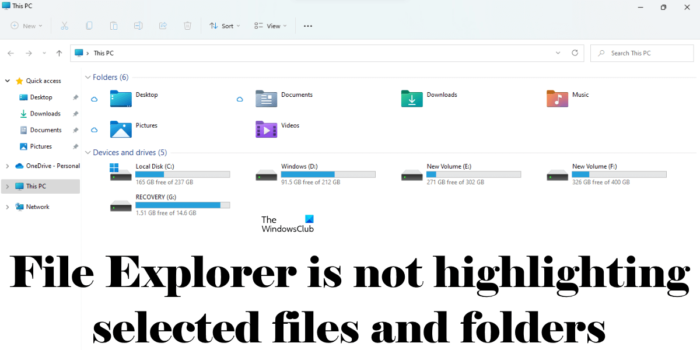
File Explorer not highlighting selected files and folders
If File Explorer does not highlight the selected files and folders, the solutions below can help you fix the problem.
- Restart Windows Explorer
- Update or reinstall your display driver
- Toggle High Contrast mode
- Disable Fast Startup
- Change your theme
- Troubleshoot in a Clean Boot state
- Repair system image
- Perform an In-place Upgrade
Let’s see all these fixes in detail.
1] Restart Windows Explorer
This is the first thing that you should do. In some cases, the File Explorer issues get fixed by restarting the process. Restart Windows Explorer and see if it helps. The following steps will help you:
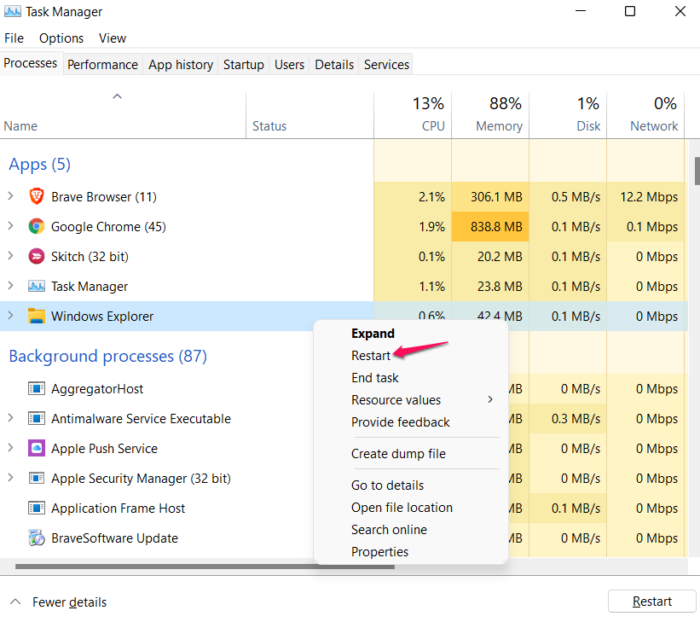
- Open the Task Manager.
- Under the Processes tab, scroll down and locate Windows Explorer.
- Once you find it, right-click on it and select Restart.
This should work. If not, try the next potential fix.
2] Update or reinstall your display driver
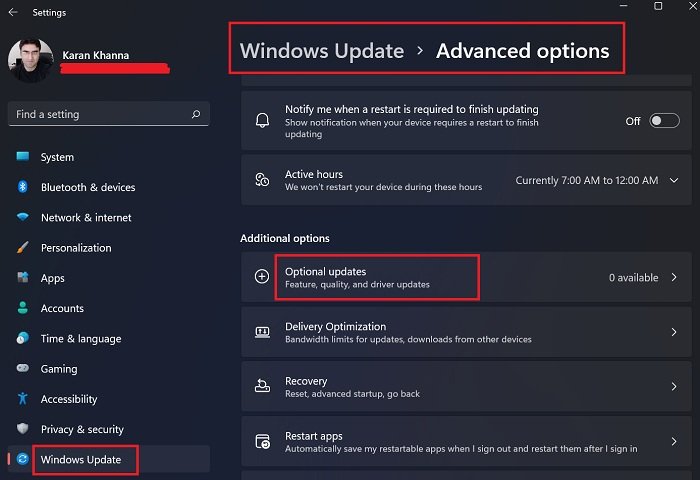
The problem may also be associated with your display driver. Open the optional Updates page in the Windows Updates category and see if an update for your display driver is available If yes, install the driver update. If this does not work or if an update is not available, uninstall and reinstall your display driver. The following instructions will guide you on this:
- Download the latest version of your display driver from the manufacturer’s website.
- Open the Device Manager.
- Expand the Display adapters node.
- Right-click on your display driver and select Uninstall device. After this, your system will use the default display driver.
- Now, run the installer file to install the display driver manually on your system.
After the installation process gets completed, the problem should be fixed.
3] Toggle High Contrast mode
The High Contrast mode improves readability for people with poor vision. When you activate this mode, the solid color background is automatically applied to your wallpaper and the interface of your applications will change. In Windows 11, the high contrast mode is handled by Contrast Themes.
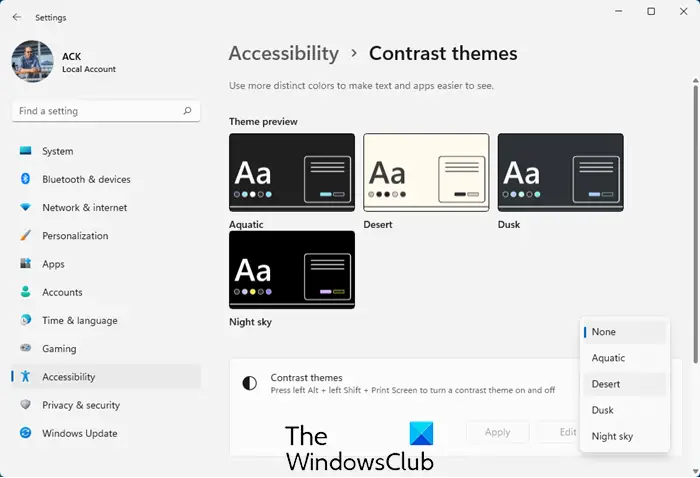
Turn on the High Contrast Mode or apply a Contrast Theme to your system and see if it helps. After applying a Contrast Theme, open File Explorer and select files and folders. Now, see if it highlights the selected files and folders. If yes, you can disable the High Contrast mode. This should fix the issue.
4] Disable Fast Startup
Fast Startup starts your system quickly after shutdown. Sometimes, Fast Startup creates problems on a Windows device. In this case, disabling the Fast Startup helps.
5] Change your theme
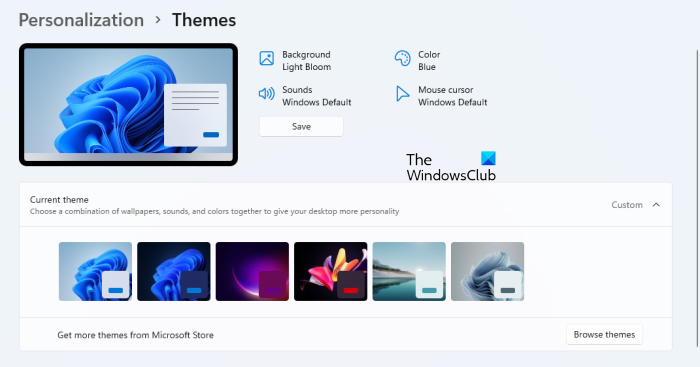
You can also try changing your theme. This solution has worked for some users. Therefore, it should also work for you. To change your theme, open Windows 11/10 Settings and go to “Personalization > Themes.” Now, apply a different theme to your system. You can revert back to your previous theme later.
6] Troubleshoot in a Clean Boot state
The issue might be occurring due to a conflicting background process. It might be a third-party service or a startup app. You can check this by troubleshooting your system in a Clean Boot state. To do so, you have to disable all the third-party services and startup apps via MSConfig. After this, when you start your computer, you will enter into a Clean Boot state. Now, only Microsoft services and essential drivers are active. Rest all the services and apps are disabled.
Now, open File Explorer and check if it highlights the selected files and folder. If yes, your next step is to identify what is causing the problem. Now, open MSConfig and enable some of the third-party services and startup apps and boot your computer in normal mode. Now, check if the problem persists. If the problem reappears, one of the services or startup apps is causing the problem. Start disabling the startup apps and third-party services (that you have just enabled) one by one and check if the issue is fixed. This process will take time but you will be able to identify the problematic app or service. Once you find it, uninstall the app or disable the service. To disable a particular service, open the Services Management app, open the properties of that particular service, and select Disabled in the Startup type drop-down.
7] Repair system image
If the problem still persists, some of your system image files might have been corrupted. You should run the System File Checker tool to repair the corrupted system image files. If the SFC scan does not work, run the DISM scan.
8] Perform an In-place Upgrade
If none of the above solutions worked for you, perform an In-place Upgrade. An In-place Upgrade repairs your Windows operating system. Also, your data will not be deleted during the In-place Upgrade. In-place Upgrade reinstalls the Windows operating system over the previous operating system without uninstalling the previous version of Windows OS.
Though it does not delete your data, we recommend you back up your data before proceeding.
Read: File Explorer keeps crashing, freezing or has stopped working.
Why doesn’t my file highlight when I click on it?
If File Explorer is not highlighting the selected files, some of your system image files might have been corrupted. Windows has a built-in tool called System File Checker that helps users repair corrupted system image files. If the SFC scan doesn’t work, you should run the DISM scan. Another cause of this problem is the corrupted display driver. You should update or reinstall your display driver and see if it helps.
The problem might also occur due to a conflicting background application or service. You can check this by troubleshooting in a Clean Boot state. We have explained some working solutions to fix this problem in this article.
Read: How to change the Background Color of selected or highlighted Text in Windows
How do I highlight multiple files in File Explorer?
When you select a file in File Explorer, it automatically highlights it. Similarly, if you select multiple files in File Explorer, it will highlight all the selected files.
Read: How to change Translucent Selection Rectangle Box color in Windows
Can you color folders in Windows 11?
Windows 11 does not have a built-in feature to change the color of folders. If you want to change the folder colors in Windows 11, you can do so by installing third-party software. Rainbow Folders and StyleFolder are some of the free software that lets you change folder colors on Windows.
Read next: Windows Explorer High Power Usage.
Leave a Reply